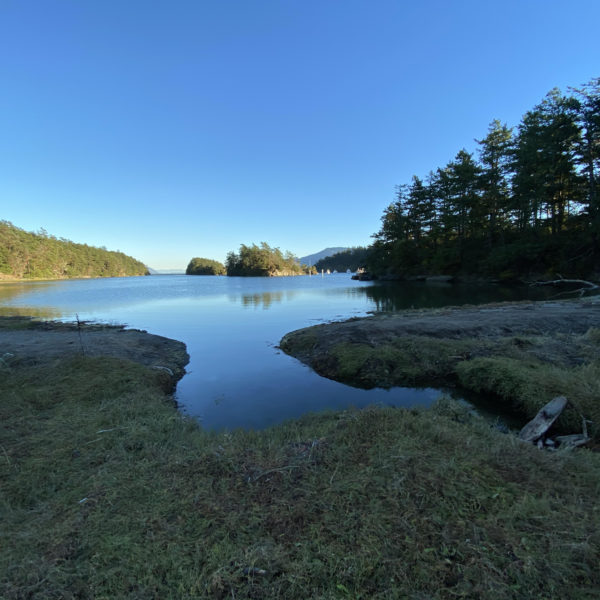Almost seven years ago, Friends of the San Juans began working with Washington State Parks on a salmon recovery project on Sucia Island. After a lot of research, surveys, designs, engineering, and permitting, the on-the-ground work to restore habitat has come to fruition.

Located along a major migratory pathway for juvenile Chinook salmon, Sucia’s marine shorelines are a top priority for salmon recovery efforts in San Juan County. Sucia’s Mud Bay hosts a forage fish spawning beach and a salt marsh, providing very rare and valuable habitat for juvenile salmon and the food web that supports fish, birds, and marine mammals.
Before last week, a decades old, low-lying road crossed the beach and salt marsh at Mud Bay. The road blocked tidal exchange and fish passage, burying forage fish spawning habitat, and preventing the site from adjusting to rising sea levels.
Restoration actions completed over the past two weeks included full removal of the shoreline road and its associated fill, rock, concrete armoring, and the undersized culvert. The beach was nourished with rounded sand and small gravel. To allow full restoration, a new low impact road was installed at an inland location to provide Parks staff access to their maintenance buildings.

“It was amazing to see the tide coming into the marsh unimpeded for the first time in over 75 years. The restored habitat will now directly support migrating juvenile salmon, forage fish, and through the marine food web, our endangered orca” said Tina Whitman, Science Director, Friends of the San Juans.
After a formal bidding process, the public works contract was awarded to Mike Carlson Enterprises of San Juan Island, who worked with additional local contractors including Rain Shadow Consulting of Orcas Island. The restoration design and engineering were completed by Coastal Geologic Services of Bellingham.
During a break in the final day of construction, Mike Carlson said, “What I like about a project like this is figuring out all of the logistics like getting the materials, crew, and equipment to the site and turning the design into three dimensions. I enjoyed working with the Friends – the whole project team was great. I think the end result of what we did and what we took out and the way we left the beach is a real plus for everybody.”
Funding was provided from multiple sources: Washington Salmon Recovery Funding Board, Estuary and Salmon Restoration Program, Department of Ecology Coastal Protection Fund, the U.S. Fish & Wildlife Service, and members of Friends of the San Juans. Washington State Parks, project partner from the beginning, is providing in-kind assistance.
“State Parks appreciates the opportunity to collaborate with partners like the Friends of the San Juans. We are stronger together and great things can happen when we work towards a common goal. Both organizations share the goal of stewardship of the precious lands and water entrusted to our care,” said Chris Guidotti from Washington State Parks.
“This project succeeds on so many levels,” said Brent Lyles, Executive Director, Friends of the San Juans, “It built strong local partnerships and restored critically important habitat. But more than that, Sucia Island is beloved by so many. Just yesterday, one of our members told me that he first visited Sucia with his grandfather, so seeing the beach and salt marsh improved is profoundly, personally meaningful. This is the Friends’ mission in action, protecting and restoring the San Juan Islands for people and nature.”
While the bulk of the hard costs for this project are covered by grants, member support is critical. Your donations keep our marine ecosystem recovery and protection programs strong. Donate today — because you can help increase our salmon recovery efforts. Thank you for your support!
